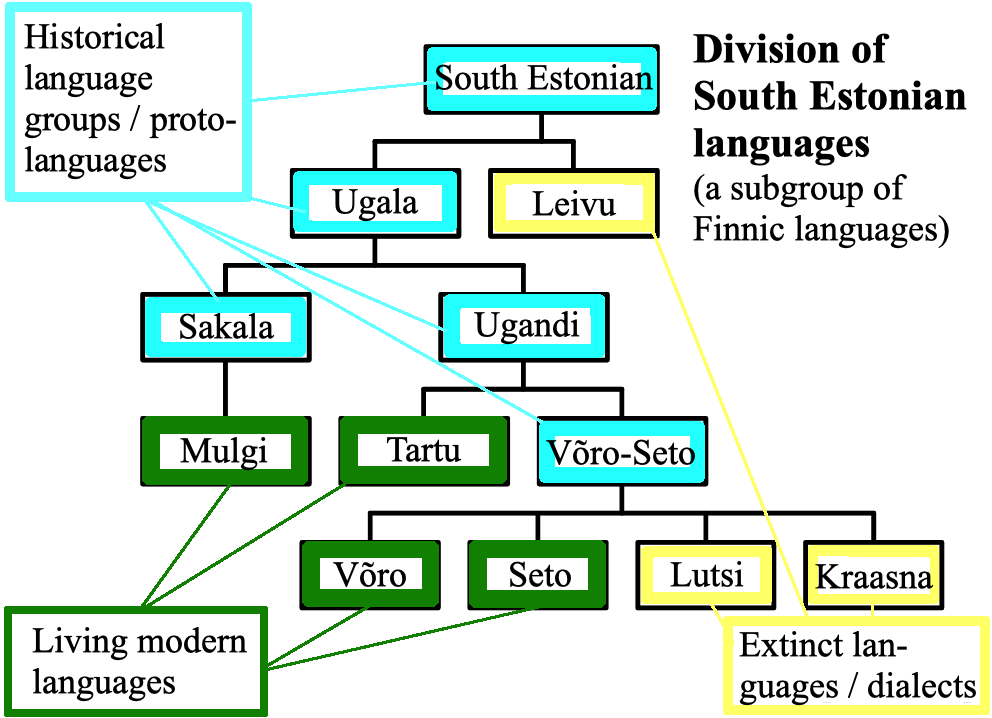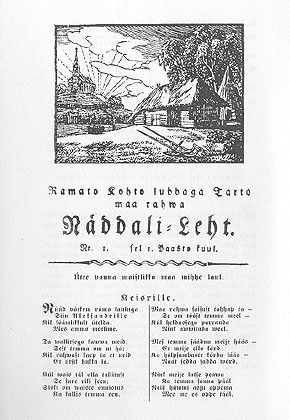South Estonian language on:
[Wikipedia]
[Google]
[Amazon]

 South Estonian, or Võro-Seto, is a Finnic language spoken in south-eastern
South Estonian, or Võro-Seto, is a Finnic language spoken in south-eastern
 The two different historical Estonian languages, North and South Estonian, are based on the ancestors of modern Estonians' migration into the territory of Estonia in at least two different waves, both groups speaking differing Finnic vernaculars. Some of the most ancient
The two different historical Estonian languages, North and South Estonian, are based on the ancestors of modern Estonians' migration into the territory of Estonia in at least two different waves, both groups speaking differing Finnic vernaculars. Some of the most ancient

 South Estonian began to undergo a revival in the late 1980s. Today, South Estonian is used in the works of some of Estonia's most well-known playwrights, poets, and authors. Most success has been achieved in promoting a new literary standard based on Võro. Mulgi and especially Tartu, however, have very few speakers left. The 2011 census in Estonia counted 101,857 self-reported speakers of South Estonian: 87,048 speakers of Võro (74,499 when excluding 12,549 Seto speakers), 9,698 Mulgi speakers, 4,109 Tartu language speakers and 1,002 who didn't specify a variety.
South Estonian began to undergo a revival in the late 1980s. Today, South Estonian is used in the works of some of Estonia's most well-known playwrights, poets, and authors. Most success has been achieved in promoting a new literary standard based on Võro. Mulgi and especially Tartu, however, have very few speakers left. The 2011 census in Estonia counted 101,857 self-reported speakers of South Estonian: 87,048 speakers of Võro (74,499 when excluding 12,549 Seto speakers), 9,698 Mulgi speakers, 4,109 Tartu language speakers and 1,002 who didn't specify a variety.Rahva ja eluruumide loendus 2011 – emakeel ja eesti emakeelega rahvastiku murdeoskus
/ref> The 2021 census in Estonia counted 128,590 self-reported speakers of South Estonian among native speakers: 97,320 speakers of Võro (72,240 when excluding 25,080 Seto speakers), 17,310 Tartu language speakers and 13,960 Mulgi speakers. Language sample of modern literary ( Võro) South Estonian: Article 1 of the
Võro Institute
{{DEFAULTSORT:South Estonian Language South Estonian language Finnic languages Languages of Estonia Languages of Latvia Languages of Russia Estonian dialects

 South Estonian, or Võro-Seto, is a Finnic language spoken in south-eastern
South Estonian, or Võro-Seto, is a Finnic language spoken in south-eastern Estonia
Estonia, officially the Republic of Estonia, is a country in Northern Europe. It is bordered to the north by the Gulf of Finland across from Finland, to the west by the Baltic Sea across from Sweden, to the south by Latvia, and to the east by Ru ...
, encompassing the Tartu
Tartu is the second largest city in Estonia after Tallinn. Tartu has a population of 97,759 (as of 2024). It is southeast of Tallinn and 245 kilometres (152 miles) northeast of Riga, Latvia. Tartu lies on the Emajõgi river, which connects the ...
, Mulgi, Võro and Seto dialects. Diachronically speaking, Estonian and South Estonian are in separate branches of the Finnic languages, with Estonian being more closely related to Finnish than it is to South Estonian.
Note that reconstructed *č and *c stand for affricates , .
Modern Standard Estonian has evolved on the basis of the dialects of Northern Estonian. However, from the 17th to the 19th centuries in Southern Estonia, literature was published in a standardized form of Southern Tartu and Northern Võro. That usage was called Tartu or literary South Estonian. The written standard was used in the schools, churches and courts of the Võro and Tartu linguistic area but not in the Seto and Mulgi areas.
After Estonia gained independence in 1918, the standardized Estonian language policies were implemented further throughout the country. The government officials during the era believed that the Estonian state needed to have one standard language for all of its citizens, which led to the exclusion of South Estonian in education. The ban on the instruction and the use of South Estonian dialects in schools continued during the Soviet occupation (1940–1990).
Since Estonia regained independence in 1991, the Estonian government has become more supportive of the protection and development of South Estonian. A modernized literary form founded on the Võro dialect of South Estonian has been sanctioned.
Varieties
The extant varieties of the South Estonian language area are Mulgi, Tartu, Võro and Seto. Võro and Seto have remained furthest from the standard written Estonian language and are most difficult for speakers of standard Estonian to understand. Threeenclave
An enclave is a territory that is entirely surrounded by the territory of only one other state or entity. An enclave can be an independent territory or part of a larger one. Enclaves may also exist within territorial waters. ''Enclave'' is so ...
s of South Estonian are attested. The Leivu and Lutsi dialects in Latvia became extinct in the 20th century. The Kraasna enclave in Russia, still aware of their identity, have been assimilated linguistically by Russians.
Characteristics
The distinction between South Estonian and North Estonian is starker than any other contrast between Estonian dialects, and is present at every level of the language. Phonological differences include: Morphological differences:History
 The two different historical Estonian languages, North and South Estonian, are based on the ancestors of modern Estonians' migration into the territory of Estonia in at least two different waves, both groups speaking differing Finnic vernaculars. Some of the most ancient
The two different historical Estonian languages, North and South Estonian, are based on the ancestors of modern Estonians' migration into the territory of Estonia in at least two different waves, both groups speaking differing Finnic vernaculars. Some of the most ancient isogloss
An isogloss, also called a heterogloss, is the geographic boundary of a certain linguistics, linguistic feature, such as the pronunciation of a vowel, the meaning of a word, or the use of some morphological or syntactic feature. Isoglosses are a ...
es within the Finnic languages separate South Estonian from the entire rest of the family, including a development *čk → ''tsk'', seen in for example *kačku → Standard Estonian ''katk'' "plague", Finnish ''katku'' "stink", but South Estonian ''katsk''; and a development *kc → ''tś'', seen in for example *ükci "one" → Standard Estonian ''üks'', Finnish ''yksi'', but South Estonian ''ütś''.
The first South Estonian grammar was written by Johann Gutslaff in 1648 and a translation of the New Testament (''Wastne Testament'') was published in 1686. In 1806 the first Estonian newspaper ''Tarto-ma rahwa Näddali leht'' was published in Tartu literary South Estonian.
Comparison of old literary South Estonian (Tartu), modern literary South Estonian (Võro) and modern standard Estonian:
'' Lord's Prayer'' (''Meie Esä'') in old literary South Estonian (Tartu):
''Lord's Prayer'' (''Mi Esä'') in modern literary South Estonian ( Võro):
''Lord's Prayer'' (''Meie isa'') in modern standard Estonian:
The South Estonian literary language declined after the 1880s as the northern literary language became the standard for Estonian. Under the influence of the European liberal-oriented nationalist movement it was felt that there should be a unified Estonian language. The beginning of the 20th century saw a period for the rapid development of the northern-based variety.
Present situation
 South Estonian began to undergo a revival in the late 1980s. Today, South Estonian is used in the works of some of Estonia's most well-known playwrights, poets, and authors. Most success has been achieved in promoting a new literary standard based on Võro. Mulgi and especially Tartu, however, have very few speakers left. The 2011 census in Estonia counted 101,857 self-reported speakers of South Estonian: 87,048 speakers of Võro (74,499 when excluding 12,549 Seto speakers), 9,698 Mulgi speakers, 4,109 Tartu language speakers and 1,002 who didn't specify a variety.
South Estonian began to undergo a revival in the late 1980s. Today, South Estonian is used in the works of some of Estonia's most well-known playwrights, poets, and authors. Most success has been achieved in promoting a new literary standard based on Võro. Mulgi and especially Tartu, however, have very few speakers left. The 2011 census in Estonia counted 101,857 self-reported speakers of South Estonian: 87,048 speakers of Võro (74,499 when excluding 12,549 Seto speakers), 9,698 Mulgi speakers, 4,109 Tartu language speakers and 1,002 who didn't specify a variety./ref> The 2021 census in Estonia counted 128,590 self-reported speakers of South Estonian among native speakers: 97,320 speakers of Võro (72,240 when excluding 25,080 Seto speakers), 17,310 Tartu language speakers and 13,960 Mulgi speakers. Language sample of modern literary ( Võro) South Estonian: Article 1 of the
Universal Declaration of Human Rights
The Universal Declaration of Human Rights (UDHR) is an international document adopted by the United Nations General Assembly that enshrines the Human rights, rights and freedoms of all human beings. Drafted by a UN Drafting of the Universal D ...
:
''Kõik inemiseq sünnüseq vapos ja ütesugumaidsis uma avvo ja õiguisi poolõst. Näile om annõt mudsu ja süämetunnistus ja nä piät ütstõõsõga vele muudu läbi käümä.''
''All human beings are born free and equal in dignity and rights. They are endowed with reason and conscience and should act towards one another in a spirit of brotherhood.''
See also
* Võro language * Seto dialect *Finnic languages
The Finnic or Baltic Finnic languages constitute a branch of the Uralic language family spoken around the Baltic Sea by the Baltic Finnic peoples. There are around 7 million speakers, who live mainly in Finland and Estonia.
Traditionally, ...
* Centre for South Estonian Language and Cultural Studies
* Võro Institute
References
Bibliography
* Eller, Kalle (1999): ''Võro-Seto language''. Võro Instituut'. Võro. * Iva, Sulev; Pajusalu, Karl (2004): The Võro Language: Historical Development and Present Situation. In: ''Language Policy and Sociolinguistics I: "Regional Languages in the New Europe" International Scientific Conference; Rēzeknes Augstskola, Latvija; 20–23 May 2004''. Rezekne: Rezekne Augstskolas Izdevnieceba, 2004, 58 – 63. * Kask, Arnold (1984): ''Eesti murded ja kirjakeel''. Emäkeele seltsi toimetised 16.External links
Võro Institute
{{DEFAULTSORT:South Estonian Language South Estonian language Finnic languages Languages of Estonia Languages of Latvia Languages of Russia Estonian dialects